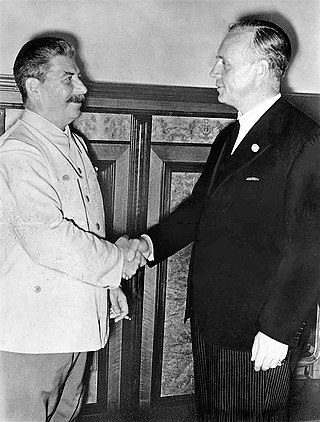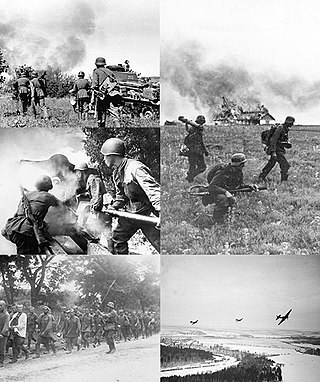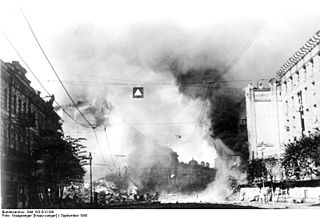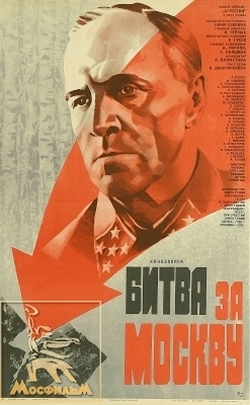Related Research Articles

The Molotov–Ribbentrop Pact, officially the Treaty of Non-Aggression between Germany and the Union of Soviet Socialist Republics, was a non-aggression pact between Nazi Germany and the Soviet Union with a secret protocol that partitioned Central and Eastern Europe between them. The pact was signed in Moscow on 23 August 1939 by German Foreign Minister Joachim von Ribbentrop and Soviet Foreign Minister Vyacheslav Molotov. Unofficially, it has also been referred to as the Hitler–Stalin Pact, or Nazi–Soviet Pact.

Operation Barbarossa was the invasion of the Soviet Union by Nazi Germany and many of its Axis allies, starting on Sunday, 22 June 1941, during the Second World War. It was the largest land offensive in human history, with around 10 million combatants taking part. The operation, code-named after Frederick Barbarossa, a 12th-century Holy Roman Emperor and Crusader, put into action Nazi Germany's ideological goal of conquering the western Soviet Union to repopulate it with Germans. The German Generalplan Ost aimed to use some of the conquered people as forced labour for the Axis war effort while acquiring the oil reserves of the Caucasus as well as the agricultural resources of various Soviet territories, including Ukraine and Byelorussia. Their ultimate goal was to create more Lebensraum for Germany, and the eventual extermination of the native Slavic peoples by mass deportation to Siberia, Germanisation, enslavement, and genocide.

The Workers' and Peasants' Red Army, often shortened to the Red Army, was the army and air force of the Russian Soviet Republic and, from 1922, the Soviet Union. The army was established in January 1918 by Leon Trotsky to oppose the military forces of the new nation's adversaries during the Russian Civil War, especially the various groups collectively known as the White Army. In February 1946, the Red Army was renamed the "Soviet Army" - which in turn became the Russian Army on 7 May 1992, following the dissolution of the Soviet Union.

Georgy Konstantinovich Zhukov was a Marshal of the Soviet Union. He also served as Chief of the General Staff, Minister of Defence, and was a member of the Presidium of the Communist Party. During World War II, Zhukov oversaw some of the Red Army's most decisive victories. He was also a military governor of Germany succeeded by Wilhelm Pieck.

Semyon Konstantinovich Timoshenko was a Soviet military commander, Marshal of the Soviet Union, and one of the most prominent Red Army commanders during the Second World War.

Andrey Andreyevich Vlasov was a Soviet Red Army general and collaborator with Germany. During the Axis-Soviet campaigns of World War II he fought (1941–1942) against the Wehrmacht in the Battle of Moscow and later was captured attempting to lift the siege of Leningrad. After his capture he defected to Germany and headed the Russian Liberation Army. Initially this army existed only on paper and was used by Germans to goad Red Army troops to surrender; only in 1944 did Heinrich Himmler, aware of Germany's shortage of manpower, arrange for Vlasov to form a real collaborationist army formed from Soviet prisoners of war. At the war's end, Vlasov changed sides again and ordered the ROA to aid the May 1945 Prague uprising against the Germans. He and the ROA then tried to escape to the Western Front, but were captured by Soviet forces with the United States' assistance. Vlasov was tortured, tried for treason, and hanged.

Moritz Albrecht Franz Friedrich Fedor von Bock was a German Generalfeldmarschall who served in the German Army during the Second World War. Bock served as the commander of Army Group North during the Invasion of Poland in 1939, commander of Army Group B during the Invasion of France in 1940, and later as the commander of Army Group Center during the attack on the Soviet Union in 1941; his final command was that of Army Group South in 1942.

The Eastern Front was a theatre of World War II fought between the European Axis powers and Allies, including the Soviet Union (USSR) and Poland. It encompassed Central Europe, Eastern Europe, Northeast Europe (Baltics), and Southeast Europe (Balkans), and lasted from 22 June 1941 to 9 May 1945. Of the estimated 70–85 million deaths attributed to World War II, around 30 million occurred on the Eastern Front, including 9 million children. The Eastern Front was decisive in determining the outcome in the European theatre of operations in World War II, eventually serving as the main reason for the defeat of Nazi Germany and the Axis nations.

The Battle of Moscow was a military campaign that consisted of two periods of strategically significant fighting on a 600 km (370 mi) sector of the Eastern Front during World War II, between September 1941 and January 1942. The Soviet defensive effort frustrated Hitler's attack on Moscow, the capital and largest city of the Soviet Union. Moscow was one of the primary military and political objectives for Axis forces in their invasion of the Soviet Union.

Semyon Mikhailovich Budyonny was a Soviet cavalryman, military commander during the Russian Civil War, Polish-Soviet War and World War II, and politician, who was a close political ally of Soviet leader Joseph Stalin.

Ivan Stepanovich Konev was a Soviet general and Marshal of the Soviet Union who led Red Army forces on the Eastern Front during World War II, responsible for taking much of Axis-occupied Eastern Europe.

German–Soviet Union relations date to the aftermath of the First World War. The Treaty of Brest-Litovsk, dictated by Germany ended hostilities between Russia and Germany; it was signed on March 3, 1918. A few months later, the German ambassador to Moscow, Wilhelm von Mirbach, was shot dead by Russian Left Socialist-Revolutionaries in an attempt to incite a new war between Russia and Germany. The entire Soviet embassy under Adolph Joffe was deported from Germany on November 6, 1918, for their active support of the German Revolution. Karl Radek also illegally supported communist subversive activities in Weimar Germany in 1919.

The First Battle of Kiev was the German name for the operation that resulted in an encirclement of Soviet troops in the vicinity of Kiev during World War II. This encirclement is considered the largest encirclement in the history of warfare by number of troops. The operation ran from 7 July to 26 September 1941 as part of Operation Barbarossa, the Axis invasion of the Soviet Union.

Erich Kurt Richard Hoepner was a German general during World War II. An early proponent of mechanisation and armoured warfare, he was a Wehrmacht army corps commander at the beginning of the war, leading his troops during the invasion of Poland and the Battle of France.

Filipp Ivanovich Golikov was a Soviet military commander. As chief of the GRU, he is best known for failing to take seriously the abundant intelligence about Nazi Germany's plans for an invasion of the Soviet Union in June 1941, either because he did not believe them or because Joseph Stalin did not want to hear them. He served in subsequent campaigns and was promoted to the rank of Marshal of the Soviet Union in 1961.

The Soviet invasion of Poland was a military conflict by the Soviet Union without a formal declaration of war. On 17 September 1939, the Soviet Union invaded Poland from the east, 16 days after Nazi Germany invaded Poland from the west. Subsequent military operations lasted for the following 20 days and ended on 6 October 1939 with the two-way division and annexation of the entire territory of the Second Polish Republic by Nazi Germany and the Soviet Union. This division is sometimes called the Fourth Partition of Poland. The Soviet invasion of Poland was indirectly indicated in the "secret protocol" of the Molotov–Ribbentrop Pact signed on 23 August 1939, which divided Poland into "spheres of influence" of the two powers. German and Soviet cooperation in the invasion of Poland has been described as co-belligerence.

In Soviet historiography, Stalin's ten blows were the ten successful strategic offensives conducted by the Red Army in 1944 during World War II. The Soviet offensives drove the Axis forces from Soviet territory and precipitated Nazi Germany's collapse.

After the Munich Agreement, the Soviet Union pursued a rapprochement with Nazi Germany. On 23 August 1939 the Soviet Union signed a non-aggression pact with Germany which included a secret protocol that divided Eastern Europe into German and Soviet "spheres of influence", anticipating potential "territorial and political rearrangements" of these countries. Germany invaded Poland on 1 September 1939, starting World War II. The Soviets invaded eastern Poland on 17 September. Following the Winter War with Finland, the Soviets were ceded territories by Finland. This was followed by annexations of the Baltic states and parts of Romania.

The Soviet offensive plans controversy was a debate among historians in the late 20th and early 21st centuries as to whether Joseph Stalin had planned to launch an attack against Nazi Germany in the summer of 1941. The controversy started with Viktor Suvorov with his 1980s book Icebreaker:Who started the Second World War? where he argued, based on his analysis of historical documents and data, that Stalin used Nazi Germany as a proxy to attack Europe.

The Battle of Moscow is a 1985 Soviet two-part war film, presenting a dramatized account of the 1941 Battle of Moscow and the events preceding it. The films were a Soviet-East German-Czechoslovak-Vietnamese co-production directed by Yuri Ozerov who also wrote the script. It was made in time for the 40th anniversary of the Allied victory over Nazi Germany and the 20th anniversary of the proclamation of the Victory Day holiday and Moscow's declaration as a Hero City.
References
- ↑ Stephenson, Nigel (11 August 2014). "History man Al Stewart digs deep for musical "time passages"". Reuters. Retrieved 26 June 2021.
- 1 2 Songfacts: Roads to Moscow